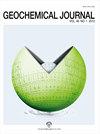花中正构烷烃的平均链长比现代植物的叶子短:对土壤中正构烷烃衍生代用品使用的影响
IF 1.6
4区 地球科学
Q3 GEOCHEMISTRY & GEOPHYSICS
引用次数: 0
摘要
(Andersson et al., 2011;Bush and McInerney, 2015)。古环境研究中对正构烷烃参数的解释主要基于现代植物叶片的正构烷烃分布。然而,除了植物的叶子,大多数其他植物器官,如花和根,也可以产生大量的烷烃。例如,Gamarra和Kahmen(2015)认为,花可能平均为草地土壤贡献7%的烷烃。在本研究中,我们收集了不同植物物种的花和叶样品,比较了花和叶之间正构烷烃的分布和丰度。该结果将有助于现代植物中有限的正构烷烃数据集,并有助于解释沉积物中正构烷烃衍生的代用品。本文章由计算机程序翻译,如有差异,请以英文原文为准。
Shorter average chain length of n-alkanes from flowers than leaves of modern plants: Implications for the use of n-alkane-derived proxies in soils
(Andersson et al., 2011; Bush and McInerney, 2015). The interpretation of n-alkane parameters in paleoenvironmental studies has been based primarily on the n-alkane distribution of leaves in modern plants. Besides plant leaves, however, most other plant organs, e.g., flowers and roots, can also produce a large amount of nalkanes. For example, Gamarra and Kahmen (2015) suggested that flowers might contribute an average of 7% nalkanes to grassland soils. In this study, we collected flower and leaf samples from different plant species to compare the distribution and abundance of n-alkane between flowers and leaves. The results would contribute to the limited data set of n-alkanes in modern plants and aid in the interpretation of n-alkane-derived proxies in sediments.
求助全文
通过发布文献求助,成功后即可免费获取论文全文。
去求助
来源期刊

Geochemical Journal
地学-地球化学与地球物理
CiteScore
1.70
自引率
12.50%
发文量
11
审稿时长
6 months
期刊介绍:
Geochemical Journal is an international journal devoted to original research papers in geochemistry and cosmochemistry. It is the primary journal of the Geochemical Society of Japan. Areas of research are as follows:
Cosmochemistry; Mineral and Rock Chemistry; Volcanology and Hydrothermal Chemistry; Isotope Geochemistry and Geochronology; Atmospheric Chemistry; Hydro- and Marine Chemistry; Organic Geochemistry; Environmental Chemistry.
 求助内容:
求助内容: 应助结果提醒方式:
应助结果提醒方式:


